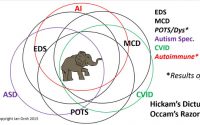Check Your Imposter Syndrome
What ever does Imposter Syndrome have to do with my connective tissue disorders and autism, Jan? Well… possibly a lot.
First off, what is Imposter Syndrome? Well, at its heart, it’s a feeling that one doesn’t belong in a given community, or at the level they are operating in a given community. Whether as an employee at work (some managers and higher-ups can experience this), a performer in school or the arts, or, IMHO, as a suspecting EDS/HSD patient or autistic person.

Yes, I feel strongly that our community is prone to Imposter Syndrome around having a form of Ehlers-Danlos syndrome (EDS) or Hypermobility Spectrum Disorder (HSD), and also around being autistic or not, especially in the late-diagnosed. And I also feel strongly this lends to further gaslighting and denial of both conditions in some folks.
Gatekeeping by members of both communities doesn’t help – that is, saying “only the select few who jump all these painful hurdles I had to jump and pay enough money to get diagnosed can be allowed in this club”. Ouch. Please check your privilege. I’ve seen this a lot in both communities (which often overlap, we’re now slowly realizing). Diagnosis is still a rare privilege not all can afford easily yet for numerous reasons.
Yes, I agree, we need to do proper differential diagnosis for both conditions. That is, make sure to do a proper workup, and rule out anything else they could be that is similar. But…if we only uphold and laud the grossest signs of the rarest forms of them, then only a few will feel like they belong, and we will continue to dismiss many others who may well also belong as we’re slowly realizing.
This has been the case in both camps. For almost a century, we’ve only described a few stereotyped signs of autism in white cis-het boys and men in Germany back in the 1930s. This led to dismissing and failing to recognized better masked and different signs in not only all other genders, but even some other boys and men who didn’t closely match this small, stereotyped subset of signs.
(Please avoid gendering autism – this can lend to further imposter syndrome, and gender dysphoria in those who share many signs, but not the same gender as your description, right?)
The DSM is based on mostly white people’s opinion of what constitutes a psychological condition or developmental disorder and who has it. And this colonization of western medicine has continued to further pathologize autism in Black and Brown people, and dismiss it in anyone but those cis-het white boys and men who fit the original stereotyped descriptions back in Germany.
Black boys are often misdiagnosed with behavioral disorders and sent to detention and/or jail instead. (Or killed, as happened to Elijah McClain.) For some of the same autistic behaviors as their white counterparts.
So, of course, a good number of folks who don’t match the present stereotypes are going to have imposter syndrome as they aren’t represented in medicine or Hollywood, who helps gel these stereotypes.
Ditto with the forms of EDS and HSDs. We mostly know about and focus on the grossest signs of the rarest types – super stretchy skin, super bendy joints. Millions around the world have milder signs, but just as much trouble, but get dismissed because they fail to match up to that limited stereotype doctors know or can manage to remember. (In their defense, they have to learn hundreds of conditions and things, so, I’ll cut them a little slack.)
But this is why we created the EDS Toolkit for Doctors – to help make recognizing one of the most common conditions they see more “visible”. To start to suspect a connective tissue disorder sooner.
But in the meantime, I’ve know more than one person who has many signs of either hypermobile EDS (hEDS, the most common form), or what we now call the Hypermobility Spectrum Disorders (new since 2017) to deny this possibility in themselves despite plenty of signs, in my opinion.
In one case, one person like this had a relatively large platform, and kept refusing to recognize or see the signs in herself for a couple of years after she became a public figure. (If you know, you know, I’m not into dog-piling.) Many fans and even a couple of doctors suggested she may have a form of EDS, but nope, she wasn’t having it. That’s something everyone else had. She didn’t think she was bendy enough with enough gross signs, though she admitted her family were more hypermobile than she was.
I partially blame the current leading charity and medicine for this, as again, they only promote a narrow, stereotyped body type and style, based on thin white women. Few others will even consider it for this reason, though it runs in all body types, all over the world. Many are houseless due to mental and physical disabilities. (Hello, unmedicated and unsupported ADHD and EDS…!)
Anyway, this bothered me because with her semi-large platform, her Imposter Syndrome could lead a whole lot of other folks to dismiss EDS or HSD as a possibility in themselves. if she didn’t have it, despite several signs, then they must not either. Imposter syndrome is sort of catchy that way, IMHO.
So, please check your Imposter Syndrome if you have it. And lower those gates. And stop calling these things rare. They are both just rarely diagnosed yet. Thank you.


